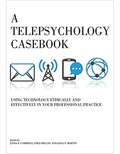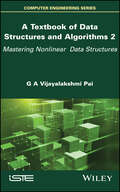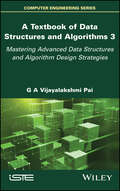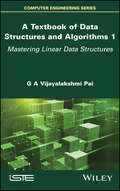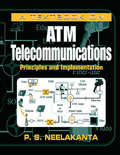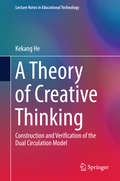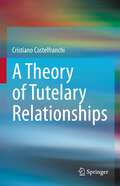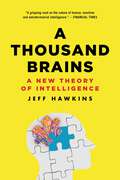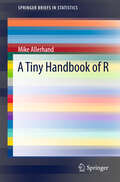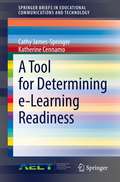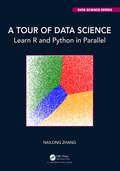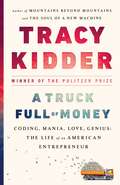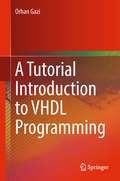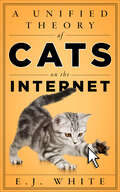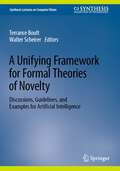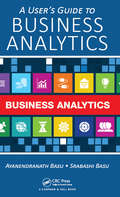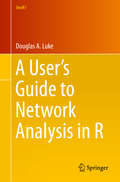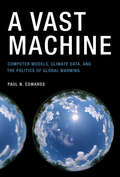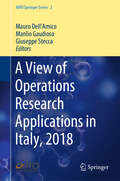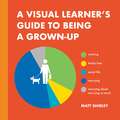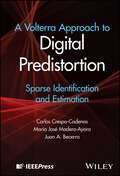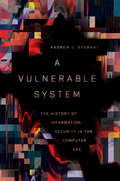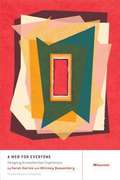- Table View
- List View
A Teen's Guide to Creating Web Pages and Blogs
by Benjamin Selfridge Peter Selfridge Jennifer OsburnWhether using a social networking site like MySpace or Facebook or building a Web page from scratch, millions of teens are actively creating a vibrant part of the Internet. This is the definitive teen's guide to publishing exciting web pages and blogs on the Web. This easy-to-follow guide shows teenagers how to: Create great MySpace and Facebook pages Build their own unique, personalized Web site Share the latest news with exciting blogging ideas Protect themselves online with cyber-safety tips Written by a teenager for other teens, this book leads readers step-by-step through the basics of web and blog design. In this book, teens learn to go beyond clicking through web sites to learning winning strategies for web design and great ideas for writing blogs that attract attention and readership.
A Telepsychology Casebook: Using Technology Ethically and Effectively in Your Professional Practice
by Linda F. CampbellThis casebook provides practical recommendations on a range of issues associated with electronic-based mental health care. <p><p>From technologies as simple as the telephone to more advanced webcams and mobile device applications, psychologists are increasingly using technology in their work—a practice known as telepsychology. Telepsychology allows clinicians to conduct remote therapy sessions, supplement in-person sessions with resources and follow-up care, collect and store client data, and more. <p><p>The book's recommendations draw from the Guidelines for the Practice of Telepsychology, which were created jointly by APA, the Association of State and Provincial Psychology Boards, and the American Insurance Trust. Each chapter presents a guideline, explains how it relates to professional ethics and standards of care, and applies it to case examples. The richly nuanced case examples depict a broad range of dilemmas that psychologists may encounter when conducing telepsychology, as well as a broad range of settings, including hospitals, community health centers, private practice, industrial/organizational settings, forensic settings, academia, military, and veterans' centers. Whatever setting you practice in, you will find guidance for applying technology effectively, legally, and ethically.
A Textbook of Data Structures and Algorithms, Volume 2: Mastering Nonlinear Data Structures
by G. A. Vijayalakshmi PaiData structures and algorithms is a fundamental course in Computer Science, which enables learners across any discipline to develop the much-needed foundation of efficient programming, leading to better problem solving in their respective disciplines. A Textbook of Data Structures and Algorithms is a textbook that can be used as course material in classrooms, or as self-learning material. The book targets novice learners aspiring to acquire advanced knowledge of the topic. Therefore, the content of the book has been pragmatically structured across three volumes and kept comprehensive enough to help them in their progression from novice to expert. With this in mind, the book details concepts, techniques and applications pertaining to data structures and algorithms, independent of any programming language. It includes 181 illustrative problems and 276 review questions to reinforce a theoretical understanding and presents a suggestive list of 108 programming assignments to aid in the implementation of the methods covered.
A Textbook of Data Structures and Algorithms: Mastering Advanced Data Structures and Algorithm Design Strategies
by G. A. Vijayalakshmi Pai<p> Data structures and algorithms is a fundamental course in Computer Science, which enables learners across any discipline to develop the much-needed foundation of efficient programming, leading to better problem solving in their respective disciplines. <p> <p> A Textbook of Data Structures and Algorithms is a textbook that can be used as course material in classrooms, or as self-learning material. The book targets novice learners aspiring to acquire advanced knowledge of the topic. Therefore, the content of the book has been pragmatically structured across three volumes and kept comprehensive enough to help them in their progression from novice to expert. <p> <p> With this in mind, the book details concepts, techniques and applications pertaining to data structures and algorithms, independent of any programming language. It includes 181 illustrative problems and 276 review questions to reinforce a theoretical understanding and presents a suggestive list of 108 programming assignments to aid in the implementation of the methods covered. <p>
A Textbook of Data Structures and Algorithms: Mastering Linear Data Structures
by G. A. Vijayalakshmi Pai<p>Data structures and algorithms is a fundamental course in Computer Science, which enables learners across any discipline to develop the much-needed foundation of efficient programming, leading to better problem solving in their respective disciplines.<p> <p>A Textbook of Data Structures and Algorithms is a textbook that can be used as course material in classrooms, or as self-learning material. The book targets novice learners aspiring to acquire advanced knowledge of the topic. Therefore, the content of the book has been pragmatically structured across three volumes and kept comprehensive enough to help them in their progression from novice to expert.<p> <p>With this in mind, the book details concepts, techniques and applications pertaining to data structures and algorithms, independent of any programming language. It includes 181 illustrative problems and 276 review questions to reinforce a theoretical understanding and presents a suggestive list of 108 programming assignments to aid in the implementation of the methods covered.<p>
A Textbook on ATM Telecommunications: Principles and Implementation
by P. S. NeelakantaWith quantum leaps in science and technology occurring at breakneck speed, professionals in virtually every field face a daunting task-practicing their discipline while keeping abreast of new advances and applications in their filed. In no field is this more applicable than in the rapidly growing field of telecommunications engineering. Practicing engineers who work with ATM technology on a daily basis must not only keep their skill sharp in areas such as ATM network interfaces, protocols, and standards, but they must also stay informed, about new classes of ATM applications.A Textbook on ATM Telecommunications gives active telecommunications engineers the advantage they need to stay sharp in their field. From the very basics of ATM to state-of-the-art applications, it covers the gamut of topics related to this intriguing switching and multiplexing strategy. Starting with an introduction to telecommunications, this text combines the theory underlying broadband communications technology with applied practical instruction and lessons gleaned from industry. The author covers fundamental communications and network theory, followed by applied ATM networking. Each chapter includes design exercises as well as worked examples .A Textbook on ATM Telecommunications includes examples of design and implementation-making it an ideal took for both aspiring and practicing telecommunication professionals.Features
A Theory of Creative Thinking: Construction and Verification of the Dual Circulation Model (Lecture Notes in Educational Technology)
by Kekang HeThis book examines research on creative thinking, both current and historical. It explores two dimensions of human thought (time and space) and two modes of thinking (conscious and unconscious) as well as both left and right brain functions and artistic and scientific creative activities. The book proposes a "Double Circulation" model of creative thinking and argues that imagery thinking, intuitive thinking and logical thinking are main parts of creative thinking and that dialectical thinking and horizontal-vertical thinking are the guides for highly complex problem-solving thoughts and strategies. The book focuses on education and psychology and also covers how to use ICT to promote students' creative thinking skills. Researchers will benefit from the "Double Circulation" model, which provides a new perspective on conducting creative thinking research. The book is also a valuable resource for graduate students in the fields of educational technology and psychology and for all readers who are interested in creative thinking.
A Theory of Tutelary Relationships
by Cristiano CastelfranchiThe purpose of the book is to propose and exploit an analytical, critical, well defined theory of a very crucial human social relation that I call “Tutelarity/ Tutelage”. This will thus explain how/why such relation is so relevant at any layer of sociality: from affective relationships, to social cooperation and interactions, to politics and democracy. The approach is theoretical and strongly grounded on cognitive science and the models of human mind: beliefs, desires, expectations, emotions, etc. Written in an accessible way, it will be of interest for a large audience, specifically to researchers and scientists interested in cognitive science and the dynamics of social relationships alike.
A Thousand Brains: A New Theory of Intelligence
by Jeff HawkinsA bestselling author, neuroscientist, and computer engineer unveils a theory of intelligence that will revolutionize our understanding of the brain and the future of AI. For all of neuroscience's advances, we've made little progress on its biggest question: How do simple cells in the brain create intelligence? Jeff Hawkins and his team discovered that the brain uses maplike structures to build a model of the world-not just one model, but hundreds of thousands of models of everything we know. This discovery allows Hawkins to answer important questions about how we perceive the world, why we have a sense of self, and the origin of high-level thought. A Thousand Brains heralds a revolution in the understanding of intelligence. It is a big-think book, in every sense of the word.
A Tiny Handbook of R (SpringerBriefs in Statistics)
by Mike AllerhandThis Brief provides a roadmap for the R language and programming environment with signposts to further resources and documentation.
A Tool for Determining e-Learning Readiness (SpringerBriefs in Educational Communications and Technology)
by Katherine Cennamo Cathy James-SpringerThis book presents a tool to determine e-learning readiness in workplace organizations. It offers a case study of the design and development process and outlines factors to be taken into account to determine e-learning readiness. It details the four objectives of this tool: to highlight specific parameters for determining e-learning readiness, to provide a systematic process to determine the readiness of an organization, to enable flexibility for the environmental context, and to capture the interrelatedness of the many areas in the organization. Next, it discusses the main element of the tool: surveys that are used to facilitate collection of data on organizational, learner and technology readiness. The book concludes with a look at practical ways of using the information gathered from the data produced.
A Tour of Data Science: Learn R and Python in Parallel (Chapman & Hall/CRC Data Science Series)
by Nailong ZhangA Tour of Data Science: Learn R and Python in Parallel covers the fundamentals of data science, including programming, statistics, optimization, and machine learning in a single short book. It does not cover everything, but rather, teaches the key concepts and topics in Data Science. It also covers two of the most popular programming languages used in Data Science, R and Python, in one source. Key features: Allows you to learn R and Python in parallel Cover statistics, programming, optimization and predictive modelling, and the popular data manipulation tools – data.table and pandas Provides a concise and accessible presentation Includes machine learning algorithms implemented from scratch, linear regression, lasso, ridge, logistic regression, gradient boosting trees, etc. Appealing to data scientists, statisticians, quantitative analysts, and others who want to learn programming with R and Python from a data science perspective.
A Truck Full of Money: One Man's Quest to Recover from Great Success
by Tracy Kidder"A perfectly executed, exquisitely reported parable of the Internet age and the wild, mad adventure that is start-up culture."--Charles Duhigg Fortune, mania, genius, philanthropy--the bestselling author of Mountains Beyond Mountains gives us the inspiring story of Paul English, the founder of Kayak.com and Lola. Tracy Kidder, the "master of the nonfiction narrative" (The Baltimore Sun) and author of the bestselling classic The Soul of a New Machine, now tells the story of Paul English, a kinetic and unconventional inventor and entrepreneur, who as a boy rebelled against authority. Growing up in working-class Boston, English discovers a medium for his talents the first time he sees a computer. As a young man, despite suffering from what would eventually be diagnosed as bipolar disorder, he begins his pilgrim's journey through the ups and downs in the brave new world of computers. Relating to the Internet as if it's an extension of his own mind, he discovers that he has a talent for conceiving innovative enterprises and building teams that can develop them, becoming "a Pied Piper" of geeks. His innovative management style, success, and innate sense of fair play inspire intense loyalty. Early on, one colleague observes: "Someday this boy's going to get hit by a truck full of money, and I'm going to be standing beside him." Yet when English does indeed make a fortune, when the travel website Kayak is sold for almost two billion dollars--the first thing he thinks about is how to give the money away: "What else would you do with it?" The second thing he thinks is, What's next? With the power of a consummate storyteller, Tracy Kidder casts a fresh, critical, and often humorous eye on the way new ideas and new money are reshaping our culture and the world. A Truck Full of Money is a mesmerizing portrait of an irresistibly endearing man who is indefatigable, original, and as unpredictable as America itself. Advance praise for A Truck Full of Money"A perfectly executed, exquisitely reported parable of the Internet age, and the wild, mad adventure that is start-up culture."--Charles Duhigg "A Truck Full of Money brings us into unknown spaces of the complex workings of the mind--of a brilliant software engineer, of this new decade, of the brutal/fast business of technology, of stunning privilege, and of one man's efforts to put his fortune to humane use."--Adrian Nicole LeBlanc"The story of [an] entrepreneur's remarkable life [and] the new American economy and the technological world that built it. More engrossing work from a gifted practitioner of narrative nonfiction."--Kirkus ReviewsFrom the Hardcover edition.
A Tutorial Introduction to VHDL Programming
by Orhan GaziThis book helps readers create good VHDL descriptions and simulate VHDL designs. It teaches VHDL using selected sample problems, which are solved step by step and with precise explanations, so that readers get a clear idea of what a good VHDL code should look like.The book is divided into eight chapters, covering aspects ranging from the very basics of VHDL syntax and the module concept, to VHDL logic circuit implementations. In the first chapter, the entity and architecture parts of a VHDL program are explained in detail. The second chapter explains the implementations of combinational logic circuits in VHDL language, while the following chapters offer information on the simulation of VHDL programs and demonstrate how to define data types other than the standard ones available in VHDL libraries. In turn, the fifth chapter explains the implementation of clocked sequential logic circuits, and the sixth shows the implementation of registers and counter packages. The book’s last two chapters detail how components, functions and procedures, as well as floating-point numbers, are implemented in VHDL. The book offers extensive exercises at the end of each chapter, inviting readers to learn VHDL by doing it and writing good code.
A Unified Theory of Cats on the Internet
by E.J. WhiteHow cats became the undisputed mascot of the internet. The advertising slogan of the social news site Reddit is "Come for the cats. Stay for the empathy." Journalists and their readers seem to need no explanation for the line, "The internet is made of cats." Everyone understands the joke, but few know how it started. A Unified Theory of Cats on the Internet is the first book to explore the history of how the cat became the internet's best friend. Internet cats can differ in dramatic ways, from the goth cats of Twitter to the glamourpusses of Instagram to the giddy, nonsensical silliness of Nyan Cat. But they all share common traits and values. Bringing together fun anecdotes, thoughtful analyses, and hidden histories of the communities that built the internet, Elyse White shows how japonisme, punk culture, cute culture, and the battle among different communities for the soul of the internet informed the sensibility of online felines. Internet cats offer a playful—and useful—way to understand how culture shapes and is shaped by technology. Western culture has used cats for centuries as symbols of darkness, pathos, and alienation, and the communities that helped build the internet explicitly constructed themselves as outsiders, with snark and alienation at the core of their identity. Thus cats became the sine qua non of cultural literacy for the Extremely Online, not to mention an everyday medium of expression for the rest of us. Whatever direction the internet takes next, the "series of tubes" is likely to remain cat-shaped.
A Unifying Framework for Formal Theories of Novelty: Discussions, Guidelines, and Examples for Artificial Intelligence (Synthesis Lectures on Computer Vision)
by Terrance Boult Walter ScheirerThis book presents the first unified formalization for defining novelty across the span of machine learning, symbolic-reasoning, and control and planning-based systems. Dealing with novelty, things not previously seen by a system, is a critical issue for building vision-systems and general intelligent systems. The book presents examples of using this framework to define and evaluate in multiple domains including image recognition image-based open world learning, hand-writing and author analysis, CartPole Control, Image Captioning, and Monopoly. Chapters are written by well-known contributors to this new and emerging field. In addition, examples are provided from multiple areas, such as machine-learning based control problems, symbolic reasoning, and multi-player games.
A User's Guide to Business Analytics
by Ayanendranath Basu Srabashi BasuA User's Guide to Business Analytics provides a comprehensive discussion of statistical methods useful to the business analyst. Methods are developed from a fairly basic level to accommodate readers who have limited training in the theory of statistics. A substantial number of case studies and numerical illustrations using the R-software package are provided for the benefit of motivated beginners who want to get a head start in analytics as well as for experts on the job who will benefit by using this text as a reference book. The book is comprised of 12 chapters. The first chapter focuses on business analytics, along with its emergence and application, and sets up a context for the whole book. The next three chapters introduce R and provide a comprehensive discussion on descriptive analytics, including numerical data summarization and visual analytics. Chapters five through seven discuss set theory, definitions and counting rules, probability, random variables, and probability distributions, with a number of business scenario examples. These chapters lay down the foundation for predictive analytics and model building. Chapter eight deals with statistical inference and discusses the most common testing procedures. Chapters nine through twelve deal entirely with predictive analytics. The chapter on regression is quite extensive, dealing with model development and model complexity from a user’s perspective. A short chapter on tree-based methods puts forth the main application areas succinctly. The chapter on data mining is a good introduction to the most common machine learning algorithms. The last chapter highlights the role of different time series models in analytics. In all the chapters, the authors showcase a number of examples and case studies and provide guidelines to users in the analytics field.
A User's Guide to Network Analysis in R (Use R!)
by Douglas LukePresenting a comprehensive resource for the mastery of network analysis in R, the goal of Network Analysis with R is to introduce modern network analysis techniques in R to social, physical, and health scientists. The mathematical foundations of network analysis are emphasized in an accessible way and readers are guided through the basic steps of network studies: network conceptualization, data collection and management, network description, visualization, and building and testing statistical models of networks. As with all of the books in the Use R! series, each chapter contains extensive R code and detailed visualizations of datasets. Appendices will describe the R network packages and the datasets used in the book. An R package developed specifically for the book, available to readers on GitHub, contains relevant code and real-world network datasets as well.
A User's Guide to the Age of Tech (Electronic Mediations)
by Grant WythoffHow users experience and influence technological change—when so much of that change feels out of our control Every day, we casually employ one of the most complex tools ever created, using it to read the news, plan our day, and connect with friends. In A User&’s Guide to the Age of Tech, Grant Wythoff investigates the process by which now-ubiquitous technologies like our phones become integrated into our lives, showing how the &“gadget&” stage—before devices are widely adopted—opens the door for users to co-create these technologies and adapt them toward unexpected ends. In this elegant, approachable work, Wythoff offers a view of how users make new technology their own, subverting dominant power structures and imagining uses never intended by their creators. Rooted in a detailed look into the history of technique (focusing on how we do things with tools rather than the tools themselves), A User&’s Guide to the Age of Tech proceeds to complicate, and influence, discussion of subjects like the digital divide and AI. Drawing on a range of sources, including novels, patents, and newspapers, Wythoff explores the vernacular philosophies that have emerged from users and their diverse, everyday practices, bringing down to earth the conversation about digital titans, away from the abstracted domains of server farms and algorithms. Lodging a passionate argument that we know ourselves better than the data brokers who appear to wield influence over our psyches, Wythoff invites readers (and tech users) to imagine their own digital technique, acknowledge their vast expertise, and see its immense value. Retail e-book files for this title are screen-reader friendly with images accompanied by short alt text and/or extended descriptions.
A Vast Machine: Computer Models, Climate Data, and the Politics of Global Warming (Infrastructures)
by Paul N. EdwardsThe science behind global warming, and its history: how scientists learned to understand the atmosphere, to measure it, to trace its past, and to model its future.Global warming skeptics often fall back on the argument that the scientific case for global warming is all model predictions, nothing but simulation; they warn us that we need to wait for real data, “sound science.” In A Vast Machine Paul Edwards has news for these skeptics: without models, there are no data. Today, no collection of signals or observations—even from satellites, which can “see” the whole planet with a single instrument—becomes global in time and space without passing through a series of data models. Everything we know about the world's climate we know through models. Edwards offers an engaging and innovative history of how scientists learned to understand the atmosphere—to measure it, trace its past, and model its future.
A View of Operations Research Applications in Italy, 2018 (AIRO Springer Series #2)
by Mauro Dell’Amico Manlio Gaudioso Giuseppe SteccaThis book presents expert descriptions of the successful application of operations research in both the private and the public sector, including in logistics, transportation, product design, production planning and scheduling, and areas of social interest. Each chapter is based on fruitful collaboration between researchers and companies, and company representatives are among the co-authors. The book derives from a 2017 call by the Italian Operations Research Society (AIRO) for information from members on their activities in promoting the use of quantitative techniques, and in particular operations research techniques, in society and industry. A booklet based on this call was issued for the annual AIRO conference, but it was felt that some of the content was of such interest that it deserved wider dissemination in more detailed form. This book is the outcome. It equips practitioners with solutions to real-life decision problems, offers researchers examples of the practical application of operations research methods, and provides Master’s and PhD students with suggestions for research development in various fields.
A Visual Learner's Guide to Being a Grown-Up
by Matt ShirleyBased on Matt Shirley's popular Instagram account, this smart and hilarious guide is a collection of tables, lists, and charts for all the visual learners out there striving to be a successful grown-up.We all know the particular pain that comes with having to be an actual adult, whether it's resetting your internet password on ten different sites, yearning for an excuse to get out of the plans your wife made for you months ago, or the anxiety that comes from forcing yourself to work out again.When Matt Shirley became fed up with being a grown-up, he started drawing charts as a more fun and efficient way to cope with his frustrations, and stuck them up on Instagram where they became an instant hit. Packed with over one hundred charts, graphs, diagrams, and infographics—with 50 percent brand-new material—this hilarious collection vows to explain everything you need to know about how to be a grown-up, covering work, family, and friends, to dating, breakups, and more.From explaining the cycle of adulthood to decoding the pros and cons of first dates to understanding the corporate lingo translator, Shirley's charts cut to the core of how to be an adult in the funniest possible way.
A Volterra Approach to Digital Predistortion: Sparse Identification and Estimation
by Carlos Crespo-Cadenas Maria Jose Madero-Ayora Juan A. BecerraThorough discussion of the theory and application of the Volterra series for impairments compensation in RF circuits and systems A Volterra Approach to Digital Predistortion: Sparse Identification and Estimation offers a comprehensive treatment of the Volterra series approach as a practical tool for the behavioral modeling and linearization of nonlinear wireless communication systems. Although several perspectives can be considered when analyzing nonlinear effects, this book focuses on the Volterra series to study systems with real-valued continuous time RF signals as well as complex-valued discrete-time baseband signals in the digital signal processing field. A unified framework provides the reader with in-depth understanding of the available Volterra-based behavioral models; in particular, the book emphasizes those models derived by exploiting the knowledge of the physical phenomena that produce different types of nonlinear distortion. From these distinctive standpoints, this work remarkably contributes to theoretical issues of behavioral modeling. The book contributes to practical state-of-the-art questions on linearization, granting the reader practical guidance in designing digital predistortion schemes and adopting up-to-date machine learning methods to exploit the sparsity of the identification problem and reducing computational complexity. Later chapters include information on: Identification of Volterra-based models as a linear regression problem, allowing the adoption of sparse machine learning methods to reduce computational complexity while keeping rich model structuresDeduction of Volterra models based on circuit model knowledge, offering pruned model structures that are better fitted for specific scenariosWireless communication systems and the nonlinear effects produced by power amplifiers, mixers, frequency converters or IQ modulatorsDigital predistortion schemes and experimental results for both indirect and direct learning architectures A Volterra Approach to Digital Predistortion: Sparse Identification and Estimation is an essential reference on the subject for engineers and technicians who develop new products for the linearization of wireless transmitters, as well as researchers and students in fields and programs of study related to wireless communications.
A Vulnerable System: The History of Information Security in the Computer Age
by Andrew J. StewartAs threats to the security of information pervade the fabric of everyday life, A Vulnerable System describes how, even as the demand for information security increases, the needs of society are not being met. The result is that the confidentiality of our personal data, the integrity of our elections, and the stability of foreign relations between countries are increasingly at risk.Andrew J. Stewart convincingly shows that emergency software patches and new security products cannot provide the solution to threats such as computer hacking, viruses, software vulnerabilities, and electronic spying. Profound underlying structural problems must first be understood, confronted, and then addressed.A Vulnerable System delivers a long view of the history of information security, beginning with the creation of the first digital computers during the Cold War. From the key institutions of the so-called military industrial complex in the 1950s to Silicon Valley start-ups in the 2020s, the relentless pursuit of new technologies has come at great cost. The absence of knowledge regarding the history of information security has caused the lessons of the past to be forsaken for the novelty of the present, and has led us to be collectively unable to meet the needs of the current day. From the very beginning of the information age, claims of secure systems have been crushed by practical reality.The myriad risks to technology, Stewart reveals, cannot be addressed without first understanding how we arrived at this moment. A Vulnerable System is an enlightening and sobering history of a topic that affects crucial aspects of our lives.
A Web for Everyone
by Whitney Quesenbery Sarah HortonIf you are in charge of the user experience, development, or strategy for a web site, A Web for Everyone will help you make your site accessible without sacrificing design or innovation. Rooted in universal design principles, this book provides solutions: practical advice and examples of how to create sites that everyone can use.

